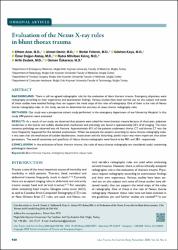Evaluation of the Nexus X-ray rules in blunt thorax trauma

Göster/
Tarih
2020Yazar
Acar, EthemDemir, Ahmet
Yıldırım, Birdal
Kaya, Gökhan
Alataş, Ömer Doğan
Kılınç, Rabia Mihriban
Özkaraca, Osman
Zeybek, Arife
Üst veri
Tüm öğe kaydını gösterÖzet
BACKGROUND: There is still no agreed radiographic rule for the evaluation of blunt thoracic trauma. Emergency physicians want radiography according to their experience and examination findings. Various studies have been carried out on this subject and some of these studies have reached findings that can support the initial steps of the rules of radiography. One of them is the rule of Nexus thorax radiography rules. In this study, we aim to determine the accuracy of nexus thorax radiography rules. METHODS: Our study was a prospective cohort study performed in the emergency department of our University Hospital. In this study, 690 patients were evaluated. RESULTS: As a result of our study, we observed that patients were asked for more thoracic trauma because of chest pain, palpation tenderness in the thorax and sudden deceleration mechanism and pathology was found in approximately 25% of all imaging. The most common pathology we observed was rib fracture. Approximately 45% of the patients underwent thorax CT, and thorax CT was the most frequently requested for the detailed examination. When we evaluate the patients according to nexus thorax radiography rules, it was seen that the mechanism of sudden deceleration, intoxication and the disturbing, painful injury was more important than other parameters. The overall sensitivity and specificity of Nexus thorax radiographs were found to be 98% and 38%, respectively. CONCLUSION: In the evaluation of blunt thoracic trauma, the rules of nexus thorax radiography are considered useful concerning pathological detection.

















